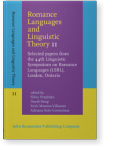Chapter 4
Pluralities of events
Semelfactives and a case of ‘single event’ nominalisation
In this paper, we tackle the issue of the semantics of semelfactive predicates by looking at ata-nominalisations built on instrument semelfactive verbs in Italian. Being nomen vicis forms, these nominalisations denote singular instances of events. The comparison allows us to cast new light on the issue of what counts as a unit in the domain of semelfactive verbs. We then apply this line of exploration to the issue of the double reading of semelfactives – semel and processive, and show that the two readings of their ata-nominalisations correspond to predicates belonging to distinct aspectual types.
Article outline
- 1.Introduction
- 1.1Semelfactives and ata-nominalisations
- 1.2Structure of the paper
- 2.
ata-nominalisations and delimited events
- 2.1Origin of the form
- 2.2Delimited events and the reading nomen vicis
- 2.3Verbal bases and aspectual constraints
- 2.4The case of instrument semelfactives
- 3.Bases and readings
- 3.1The double derivation hypothesis
- 3.2Instrument presuppositions
- 3.3Derivation, aspect, and non-existing verbs
- 3.4Plurality
- 4.Conclusions
-
Acknowledgements
-
Notes
-
References
